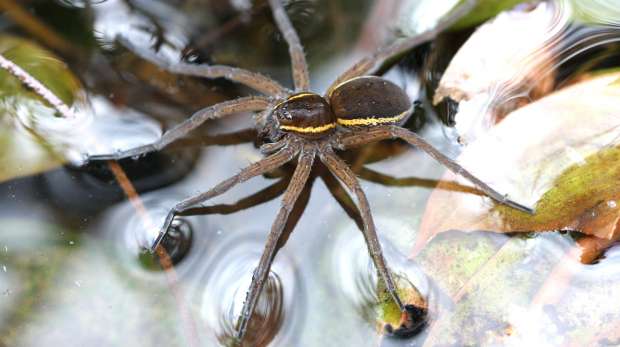
Fish-eating Spider invades Wales.
Source: BBC Wales
Thursday, 14 August 2003
The discovery of a colony of large fish-eating spiders in a Swansea canal has excited nature experts.
Countryside Council for Wales spokesman David Painter said: “Up until now, the fen raft spider was only found at UK sites, both in eastern England. “Finding a population of this size in Wales is extremely good news,” he said.
Michael Clark, of the South and West Wales Wildlife Trust, first discovered an adult fen raft spider on weeds that were floating on the Tennant Canal at Pant-y-Sais, near Jersey Marine, making this the first Welsh record of this rare spider.
Since this initial discovery, over 20 spiders have been identified, including several carrying their young.
The fen raft spider has a black or brown body nearly an inch long, with white or cream stripes along its sides. Its legs are covered in fine hairs that enable it to glide effortlessly across the water’s surface to catch prey.
The spider’s name comes from its behavior of leaning over pools from plants, dangling its front legs on the water to detect vibrations from approaching prey, primarily pond-skaters and dragonfly larvae.
It can even catch small fish such as sticklebacks as well as tadpoles.
Mr. Painter, CCW’s Warden for Crymlyn Bog and Pant-y-Sais Fen, said: “This is an exciting find. “Up until now, the fen raft spider was only found on two sites throughout the UK – both in eastern England. So, finding a population of this size in Wales is extremely good news.
It is extraordinary that such a large spider has not been noticed before!
We will now start to survey the site and other similar sites in the area – including Crymlyn Bog – and we expect to find more. The canal has been traditionally managed by the Tennant Canal Company who have helped us survey the area for new sightings of this rare spider.
This endangered species was first discovered in 1956 and has long been thought to be restricted to two sites at Lopham and Redgrave Fens on the border between Suffolk and Norfolk and the Pevensey Levels in Sussex. It is protected under the Wildlife and Countryside Act 1981 and is thought to be under threat of extinction in western and central-southern Europe whilst remaining well established in Scandinavia and the Baltic States.
CCW is the Government’s statutory adviser on sustaining natural beauty, wildlife, and the opportunity for outdoor enjoyment throughout Wales and its inshore waters.
The spider is incredibly rare and protected under schedule 5 of the Wildlife & Countryside Act 1981.